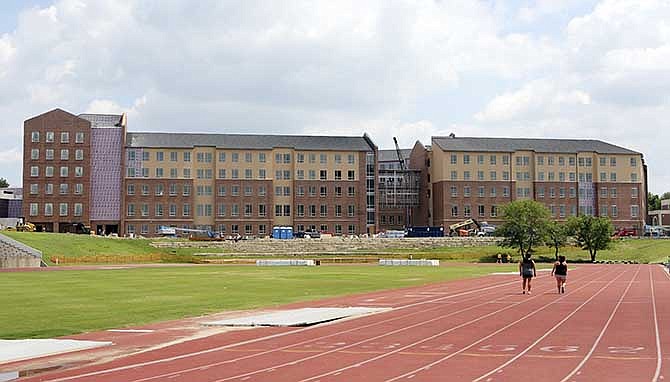WICHITA, Kan. (AP) - Universities across the nation are in the midst of a campus housing boom, replacing aging residence halls with gleaming facilities whose technology and other comforts are aimed at attracting students who demand more from college life.
Campus living for students today is a far cry from the cramped dormitories of generations past. New facilities are geared to handle laptops, smartphones and tablets and offer Wi-Fi connectivity and extra room outlets. Suites housing two or more people - with a shared bathroom instead of communal ones - are also popular, and some of the new halls feature computer labs, study centers, cafes and even a gaming room.
Fifty-two new residence halls at private and public schools to house 19,000 students opened last year or will open this year around the U.S., with a price tag of more than $2 billion, according to Paul Abramson, an analyst with New York-based Intelligence in Education who tracks college construction. Overall, the number of new residence hall construction is up from 40 that Abramson counted a year ago for his annual May survey.
The surge comes as U.S. schools are simultaneously trying to attract students with the comforts of home while fighting perceptions that tuition hikes and other expenses are putting college out of reach for a growing number of Americans. But even as costs go up, demand for updated residence halls and other amenities is motivating schools to keep spending.
At Wichita State, a new $65 million residence hall and dining facility at the center of campus has a waiting list while openings are plentiful at the university's older, lower-priced halls. It'll cost between $10,000 and $12,000 a year (including meals) to live in the new facility, compared to $6,800 a year for older residence halls.
Honors student Derick Holmes, 18, has enough scholarship money to afford campus housing, even though his family's home is just 10 minutes from campus. He'll be living in the new, tech-outfitted building, which will house his honors program and a new cafe.
"They have based it around the lives of college students today rather than 60 years ago," Holmes said.
The spurt of construction began about a decade ago and has continued to grow as colleges and universities compete for students - and their money - by offering the "cool" living experience students want and the increased security their parents demand. Plus, many residence halls put up to house the spawn of baby boomers in 1970s and early '80s were cheaply built and are ready to be torn down, Abramson said.
"What we are seeing again is a confluence of colleges stuck with a lot of stuff they didn't want, a demand suddenly from a new group of students beginning to come in - and from their parents for a better student life - and that I think drove a lot of construction," Abramson said.
Each state finances construction differently, but students who live in the new facilities ultimately pick up the tab by paying higher housing rates. Many states, like Kansas, use bonds to finance the projects - making them less dependent on lawmakers passing funding bills.
The boom seems to be spread evenly throughout the nation, according to Abramson's survey: 14 in the Northeast, 13 in the Southeast, nine in the Midwest, 10 in the mountain states and Texas and six along the West Coast.
The University of Alaska Southeast in Juneau hopes its $15 million dormitory project will retain more students in a city with a tight and expensive housing market. And Southeast Missouri State University in Cape Girardeau opened last summer a $24.5 million, suite-style housing facility, in which students with similar academic interests and career goals are grouped together on themed floors.
Changes are not confined to residence halls: More universities are now placing greater emphasis on overall campus life, providing nicer student unions and better recreational spaces unrelated to revenue-generating sports programs.
Plus, parents are also demanding better security for their children, Abramson said. More than 70 percent of the new residence facilities are using video surveillance on the exterior and more than half are using it inside, his survey found.
When John Bardo took over as Wichita State University president in 2012, it became clear to him that the school needed to lure more students to campus living. Other research colleges in similar urban areas house between 18 and 30 percent of their students on campus, but WSU only had 8 percent, he said. His goal is to eventually reach 20 percent as a means of building a culture to support the school's core mission as a major aviation research university.
"You get on average a higher retention rate, a higher graduation rate and more students who are familiar with Wichita and more likely to stay here long term," he said.

